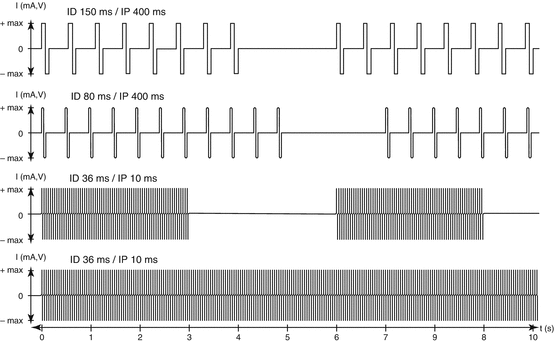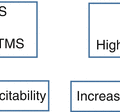Training time (months)
Functional class
Stimulation parameters
Training parameters
3–4
I or II
120 ms ID/500 ms IP; 5 s SD/2 s SP
40 ms ID/10 ms IP; 3 s SD/3 s SP
5 × 3 min 5 d/week
3 × 3 min 5 d/week
5–6
II or III
120 ms ID/400–500 ms IP; 5 s SD/1 s SP
40 ms ID/10 ms IP; 3 s SD/3 s SP
5 × 4 min 5 d/week
3 × 3 min 5 d/week
6–8
III
120 ms ID/400 ms IP; 5 s SD/1 s SP
40 ms ID/10 ms IP; 3 s SD/3 s SP
5 × 4 min 5 d/week
3–4 × 3 min 5 d/week + ankle weight 2×/week
8
III or IV
120 ms ID/400 ms IP; 5 s SD/1 s SP
40 ms ID/10 ms IP; continues + switch
5 × 4 min 5 d/week
Stand-up–sit-down exercise
Stand-up–stepping–sit-down exercise
16
V
120 ms ID/400 ms IP; 5 s SD/1 s SP
40 ms ID/10 ms IP; continues + switch
5 × 4 min 5 d/week
Walking exercise

Fig. 11.1
Parameters for progressive home-based functional electrical stimulation (h-b FES) training of long-term fully denervated human muscles. Figure shows a sample of a progressive FES training according to the described training in Table 11.1. It starts with bursts of a stimulation duration (SD) of 4 s and a stimulation pause (SP) of 2 s containing impulses with an impulse duration (ID) of 150 ms and an impulse pause (IP) of 400 ms for 4 months (it can be reduced if the time of denervation is under 6 months) to activate poor denervated muscle fibers. According to the enhanced activation, the ID can be reduced to 80 ms and SD increased to 5 s for another 4 months approximately. The next training phase implements tetanic bursts of 3 s SD and 3 s SP with impulses of 36 ms ID and 10 ms IP to increase muscle fiber diameter, muscle mass, density, and force, with leg extensions with and without additional weights on the ankles of the patients. If a good condition is achieved, depending not only to the training but also to the time span of denervation, standing, stepping-in-place, and walking exercises can be performed with continuous stimulation (controlled by an external switch) with 36 ms ID and 10 ms IP
Key Points
Elderly and mobility-impaired patients may develop severe limitations to their independence after arm and leg immobilization or being bedridden.
Education and support of patients to perform daily exercises in the hospital and then at home is an effective and low-cost measure to limit disability and improve physical and mental being of older patients, but when persons are reluctant or hampered to perform volitional exercise, functional electrical stimulation in the hospital and then at home is an alternative worth to be tested in many patients.
Section 11.1 discusses structural and molecular markers of muscle weakness and protocols of FES-induced recovery in aging and neuromuscular impairments.
Section 11.2 presents detailed protocols of h-b FES for denervated–degenerated muscles.
References
1.
2.
3.
Mosole S, Rossini K, Kern H et al (2013) Significant increase of vastus lateralis reinnervation in 70-year sportsmen with a lifelong history of high-level exercise. Eur J Transl Myol Basic Appl Myol 23:117–122
4.
5.
Mosole S, Carraro U, Kern H et al (2016) Use it or lose it: tonic activity of slow motoneurons promotes their survival and preferentially increases slow fiber-type groupings in muscles of old lifelong recreational sportsmen. Eur J Transl Myol Basic Appl Myol 26:339–346
6.
Kern H, Carraro U, Adami N, Hofer C, Loefler S, Vogelauer M, Mayr W, Rupp R, Zampieri S (2010) One year of home-based Functional Electrical Stimulation (FES) in complete lower motor neuron paraplegia: recovery of tetanic contractility drives the structural improvements of denervated muscle. Neurol Res 32:5–12CrossrefPubMed
7.
Kern H, Boncompagni S, Rossini K, Mayr W et al (2004) Long-term denervation in humans causes degeneration of both contractile and excitation-contraction coupling apparatus that can be reversed by functional electrical stimulation (FES). A role for myofiber regeneration? J Neuropathol Exp Neurol 63:919–931CrossrefPubMed
8.
Hepple RT, Rice CL (2015) Innervation and neuromuscular control in ageing skeletal muscle. J Physiol 594(8):1965–1978CrossrefPubMedPubMedCentral
9.
Carraro U, Kern H, Gava P et al (2016) Recovery from muscle weakness by exercise and FES: lessons from masters, active or sedentary seniors and SCI patients. Aging Clin Exp Res:1–12
10.
Carraro U, Kern H (2016) Severely atrophic human muscle fibers with nuclear misplacement survive many years of permanent denervation. Eur J Transl Myol 26(2):5894CrossrefPubMedPubMedCentral





